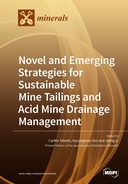Explore

Novel and Emerging Strategies for Sustainable Mine Tailings and Acid Mine Drainage Management
0 Ungluers have
Faved this Work
Login to Fave
Renewable energy and clean storage technologies are at the forefront of the world’s fight against climate change, including the UN-led move towards a carbon-neutral society. Because these complex technologies require more ‘critical’ metals and elements than fossil fuel-based technologies, the demands for raw materials in their manufacturing are skyrocketing and are projected to continue to increase into the foreseeable future.With ore grades on a steep decline, huge amounts of low-grade ores will have to be mined and processed to satisfy the world’s current and future demands for ‘critical’ metals and elements. Expansion of mining and mineral processing operations would mean more mining-related wastes—tailings, waste rocks and acid mine drainage (AMD)—notorious for their devastating and long-term destructive impacts on the environment. This Special Issue explored repurposing/reprocessing of tailings and AMD treatment cost reduction as promising alternatives to manage mine wastes more sustainably. It also includes articles on the critical roles of redox conditions and galvanic interactions on mine waste stability, hydrogeochemical controls on waste rock weathering, and climate change impacts on AMD formation in closed mines.
This book is included in DOAB.
Why read this book? Have your say.
You must be logged in to comment.
Rights Information
Are you the author or publisher of this work? If so, you can claim it as yours by registering as an Unglue.it rights holder.Downloads
This work has been downloaded 95 times via unglue.it ebook links.
- 95 - pdf (CC BY) at Unglue.it.
Keywords
- abandoned mine
- Absorption
- acid mine drainage
- Acidithiobacillus
- alkali-activated
- alkaline flotation wastewater
- alumino-silicates
- arsenic-containing tailings
- backfilling
- batch experiments
- biomining
- calcite
- coal gangue
- Comparative genomics
- concrete aggregate
- Contamination
- copper mine tailings
- copper recovery
- copper slag reprocessing tailings
- Cu-sulfide ore
- depressant
- Drainage
- dynamic leaching
- earth system model
- electricity generation
- electrochemical reduction
- endemic species
- Fe-Al bimetallic particles
- ferrous sulfate
- fluorite
- fly ash
- Geochemistry
- geopolymer
- Global warming
- goethite
- gold processing effluents
- groundwater flow analysis
- Heavy metals
- hematite
- History of engineering & technology
- Hydrogeology
- I-optimal
- immobilization
- iron hydroxide
- iron oxyhydroxide
- Kabwe
- laterite
- leaching tests
- Lead
- life cycle simulation
- magnetic susceptibility
- Magnetite
- Management
- Metals
- microbial community
- Microbial fuel cell
- Microstructure
- milk of lime
- mine tailings
- mine waste
- mine water treatment
- mining waste material
- modelling
- n/a
- native species
- nickel ore
- NMR
- Nussir
- on-land weathering conditions
- optimization
- phytoremediation
- precipitation
- Prevention
- Quartz
- RCP2.6
- RCP8.5
- red mud
- Remediation
- response surface methodology
- Røros VMS deposit
- Sampling
- scheelite
- secondary materials
- selective flotation
- sodium hydroxide
- sodium sulfide
- submarine weathering conditions
- Technology, engineering, agriculture
- Technology: general issues
- Ulveryggen
- waste rock
- Water quality
- Zambia
- Zinc
Links
DOI: 10.3390/books978-3-0365-2746-8Editions

